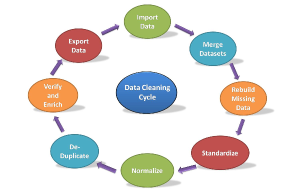We’ve all been there. Someone hands you a spreadsheet with thousands of rows of critical data, customer lists, sales records, marketing leads and it’s a complete mess. You see inconsistent names, weird formatting, blank cells, and duplicate entries everywhere. The sinking feeling in your stomach is real. Your mind immediately calculates the hours, maybe even days, it will take to whip this into shape.
But it doesn’t have to be a nightmare.
Here at Leadavail, we live and breathe data. We know that clean, reliable data is the foundation of every successful sales and marketing campaign. While our services can handle the heavy lifting of data enrichment and verification for you, we also believe in empowering you with the skills to tackle these challenges yourself.
This guide will walk you through powerful, practical Excel techniques to clean large datasets efficiently, so you can spend less time wrangling data and more time using it.

Phase 1: The Pre-Cleanup Checklist (Your Sanity Savers)
Before you change a single cell, do these three things. This is non-negotiable.
- Create a Backup!
Never work on your original file. Ever. Before you do anything else, save a copy of the spreadsheet with a new name. If you make a mistake you can’t undo, you can always go back to the original. - Define Your Goal
What does “clean” mean for this specific task? Are you preparing a list for an email campaign? Then you need valid email addresses and first names. Are you analyzing sales by region? Then your state and country columns must be standardized. Knowing your objective prevents you from getting lost in unnecessary cleaning tasks. - Format as a Table (Ctrl + T)
This is the single best thing you can do to make your life easier.
- Click anywhere inside your data range.
- Press Ctrl + T.
- Ensure the “My table has headers” box is checked.
- Click OK.
Your data is now in a structured Excel Table. Why is this a game-changer?
- Easy Sorting and Filtering: Filters are automatically added to each column header.
- Automatic Expansion: The table format automatically expands as you add new rows or columns.
- Clear Formatting: Banded rows make the data much easier to read.
Phase 2: The Core Cleaning Techniques
Now that you’re set up for success, let’s tackle the most common data messes.
1. Banish Duplicates
Duplicate entries can skew your analysis and cause you to contact the same lead multiple times. Excel has a built-in tool for this.
- Select your data table.
- Go to the Data tab.
- Click Remove Duplicates.
- In the pop-up window, check the columns that must be identical to define a duplicate (e.g., check ‘Email’ and ‘Full Name’ to find duplicate contacts).
- Click OK. Excel will tell you how many duplicate values it found and removed.
2. Tidy Up with TRIM and CLEAN
Messy exports often leave behind extra spaces and non-printable characters that break formulas and filters.
- The Problem: You see ” John Smith “ instead of “John Smith”.
- The Solution: Use the TRIM() and CLEAN() functions.
- =TRIM(A2) removes leading and trailing spaces.
- =CLEAN(A2) removes non-printable characters.
- Pro Tip: Combine them for maximum effect: =TRIM(CLEAN(A2))
How to Use It:
- Insert a new temporary column next to the column you want to clean (e.g., “Clean Name”).
- In the first cell of the new column, enter the formula =TRIM(CLEAN(A2)), assuming your messy data is in cell A2.
- Press Enter. Because you’re using an Excel Table, the formula should automatically fill down the entire column!
- Once done, Copy the entire new column and Paste as Values over the original column to finalize the changes. You can then delete the temporary column.
3. Standardize Text Casing
Inconsistent casing like “USA,” “usa,” and “Usa” can cause your data to be grouped incorrectly.
- The Solution: Use UPPER(), LOWER(), or PROPER().
- =UPPER(A2) converts text to “USA”.
- =LOWER(A2) converts text to “usa”.
- =PROPER(A2) capitalizes the first letter of each word, perfect for names: “john smith” becomes “John Smith”.
Use the same helper column technique described in the TRIM/CLEAN section.
4. Split Data with Text to Columns
You have a “Full Name” column but need separate “First Name” and “Last Name” columns for a personalized email campaign.
- Select the column you want to split.
- Go to the Data tab and click Text to Columns.
- Choose Delimited and click Next.
- Select the delimiter that separates your data (e.g., a Space for names, a Comma for addresses).
- Click Finish. Excel will split the content into the adjacent columns to the right. (Make sure you have empty columns ready!)
5. Find and Replace Inconsistencies
Your ‘State’ column has “CA,” “Calif.,” and “California.” You need them all to be “CA”.
- Press Ctrl + H to open the Find and Replace dialog.
- In the “Find what” box, enter the term you want to change (e.g., “California”).
- In the “Replace with” box, enter the standardized term (e.g., “CA”).
- Click Replace All.
- Repeat for other variations like “Calif.”.
6. Fill in the Blanks
Sometimes, reports are generated with blank cells that should contain the value from the cell above (like a category name).
- Select the column with the blanks.
- Press F5 (or Ctrl + G) to open the “Go To” dialog.
- Click Special….
- Select Blanks and click OK. All blank cells in your selection will be highlighted.
- Without clicking anywhere else, type the = sign, press the Up Arrow key, and then press Ctrl + Enter. This magical combination enters a formula in every blank cell that references the cell directly above it.
- Finally, copy this column and Paste as Values to lock in the data.
When Excel Isn’t Enough: The Next Level
These tips will save you hours. But what if you have to perform the same cleaning process every week? Or what if your data needs more than just cleaning it needs Data Enrichment Services (like finding company size or job titles for your leads)?
That’s where the real work begins, and it’s often where manual Excel processes fall short. Your time is too valuable to be spent on repetitive, mind-numbing data tasks.
At Leadavail, we specialize in transforming raw, messy data into a powerful asset. We don’t just clean your lists; we enrich them with verified contact information, firmographics, and critical insights that fuel your growth engine.

